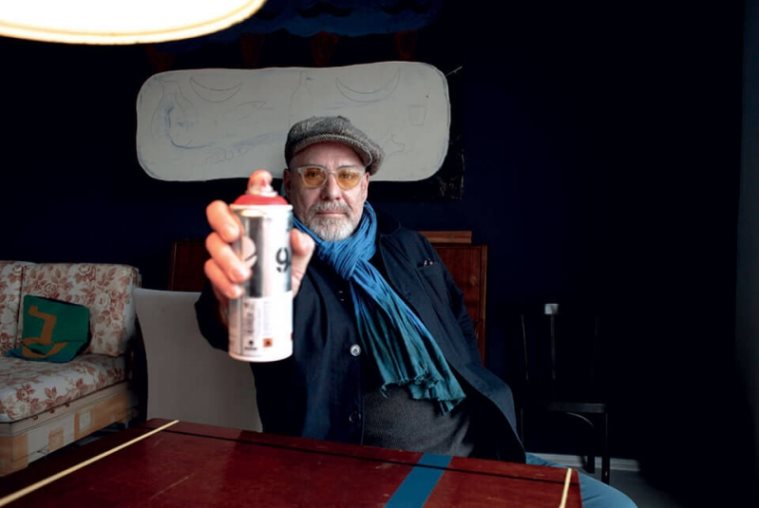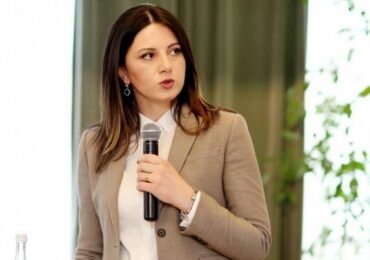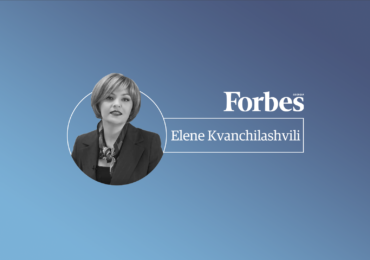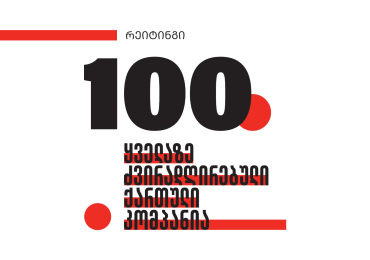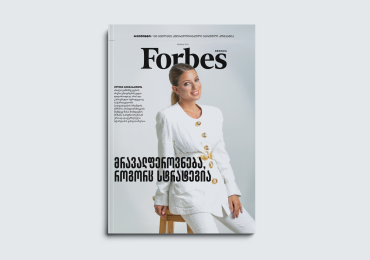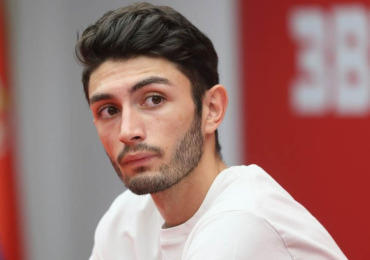Artist Gela Tsuladze left his mark not just on Tbilisi and Batumi. His latest project ‘Exhibition of the Maeght Silk Scarves’ lead to the visit of Cedric Brochier – the director of the Lyon silk factory “BROCHIER SOIERIES”. This is not an ordinary visit. The project that originated from the art landscape may grow into business. Cedric Brochier has expressed interest to produce silk in Georgia.
As I approached the seashore, I could clearly discern the black silhouette of a steel figure. I think it was a couple. They were holding a glossy red heart in their hands. Gradually, my steps were becoming faster. I wanted to see from up-close what it was, beyond which there was only sea. “
Oh, what is this? What is this? When did they put it here? Who made it?” I kept asking my friend who was walking by my side and was too hot to be interested in a steel statue of a couple with a heart in their hands. In short, I did not find out anything about the steel statue on that day. Just like everyone else, I leaned on the sculpture and settled on a rather trivial photograph.
That was about it.
At that time, I could not imagine that years later I would be doing an interview with the very author of that steel statue and many other unusual sculptures that dot the central boulevard of Batumi and elsewhere. I say ‘unusual’ because for us – those that were born and raised under the shadows of Soviet architecture – it was truly unusual to see a statue in the form of a huge egg topped with a pair of ‘beach slippers’, or even a gigantic steel bike in the center of the capital. For those of us who’ve been accustomed to various aesthetics and classical monumental forms, it was difficult to accept steel statues created by various foreign artists that are simple at first glance and ‘offensive’ to others. For example, a few years ago, social networks and various forums were flooded by comments regarding the egg and slippers statue created by French artist Lily Fantozzi.
Even if we don’t delve too far into the past, there are still a lot of discussions around the gigantic bicycle statue with two sets of handle bars and saddles stationed on Rose Revolution Square in Tbilisi. The statue belongs to French sculptor Jean Duppe. And artist Gela Tsuladze put a lot of effort to have these statues erected in Georgia.
After a nearly two-hour conversation with Tsuladze, I realized that he could easily be called a generator of ideas, because his unusual and very colorful ideas are designed not only for gallery walls, but also for the remote and gray walls that line the city streets. However, that’s not all …
A BLACK DOT ON A WHITE WALL
Gela Tsuladze was born in Tbilisi in 1959 to a family that had returned to Georgia from exile. Tsuladze’s mother is French; she is 94 and lives in Paris. Despite a successful career as a psychoanalyst, Tsuladze’s father always dreamed of returning to his homeland. In 1958, his dream came true and he returned to Tbilisi with his wife. Within a year they had a child. Tsuladze recalls that his relationship with his father helped him discover the secret of art and find freedom.
“Dad noticed from the very beginning that I liked to draw. He often took me to work and one day he asked me to help him draw a black dot on the wall. He moved a ladder close to the wall and I started drawing a black dot on a white wall with a great sense of responsibility. As it turned out, he needed the black dot to hypnotize patients. This moment remains engrained in my memory like a framed image. Later, I realized that when my father asked me to draw a black dot on the wall, he actually helped me open the window to my subconscious and gave me the keys to the mystery. That is what our life is about; we are all trying to solve some mystery, and in fact, the key to this mystery may be in our hands. That is how this black dot helped me open up my art,” Tsuladze tells me in our interview.
KUWAITI NEWSPAPER ARTIST
After finishing school, Gela Tsuladze was admitted to the Academy of Art. However, in 1980 he moved to Paris and continued his studies at the Paris Academy of Art. At the same time, he began to work as an assistant to the French conceptualist Christian Boltanski.
“We used to go everywhere together – to galleries, exhibitions … we used to talk a lot, and he kept telling me that it was time for me to do something new.”
As a 21-year-old, Tsuladze’s adventure at the Paris Academy of Arts started in a very strange manner. It turned out that there were no vacant seats in the group that he had been assigned to. So he found himself in the hallway. As if that wasn’t enough, at the suggestion of a French artist, Tsuladze gave up canvas and paper, and instead began painting on newspapers.
“One of the guards at the academy was a Kuwaiti national, he used to supply me with Kuwaiti newspapers every day. I used to sit in the hallway and draw all the time. This happened on a daily basis. I was working on myself. When you are young, you shouldn’t wait for a muse, because time flies really fast. Besides, I think that waiting for muses is a fictional story and nonsense,” the artist tells me.
So Tsuladze continued to draw abstract paintings on Kuwaiti newspapers.
“I used to put my culture, my taste and my homeland into these drawings,” he told me. “Sometimes I even placed a Georgian letter into the drawing, and at other times it was a pattern. I saved a few drawings from that time,” Tsuladze notes, recalling the time when he sold his first painting.
“A young woman paid 3,000 francs for my painting. I only knew her name – Florence. The next day, when I delivered my painting to her house, I discovered that her grandparents were founders of the famous Maeght ArtGallery. This gallery has all my favorite artists, the ones that inspire me most, including Kandinsky, Alexander Calder, and Braque. The fact thatAimé Maeght’s granddaughter was interested in my art gave me courage to carry on with my work with even more enthusiasm,” he says proudly.
“FREE FIGURATION” (FIGURATION LIBRE)
Soon Tsuladze joined a French Art movement called ‘Free Figuration’. His paintings moved from gallery to gallery. “What gallerists liked most about us, was our freedom,” says Tsuladze.
Their goal and dream was to move out of the galleries and take their art to the streets. Such was their dream. One day their dream came true.
“We were hired by a French advertising company tasked with painting advertising panels in the center of Paris. This was the first time that drawings were replaced by advertisements on large panels in Paris. We painted approximately 15 panels overnight and realized that the time for ‘street art’ had come.
Years later, Gela Tsuladze brought the idea of ‘street art’ to Georgia … but before that, he lived and worked in Spain and then in New York. I asked him where Georgia had been all that time.
“On my mind,” he said as he continued telling his story.
GEORGIA “ON MY MIND”
“My father’s parents lived out of a suitcase their entire life. They hoped that one day they would return to their homeland. They never came back, but their son lived their dream and returned to Georgia, despite the fact that he could have stayed in Paris and had a successful career there. His friends are still wondering why he made the decision to return to Georgia. However, the love for his homeland and desire to return was so great that nothing could stand in his way. It was the same in my case. I went to Paris in the 1980s, but I never cut ties with Georgia,” says Tsuladze, who arrived in Georgia in 1998 after being away for 18 years.
He returned to Georgia with one very concrete idea.
HEART INSTEAD OF THE CONSTITUTION. DOVE INSTEAD OF A TORCH.
A statue of freedom in the Black Sea. After 18 years separated from his homeland, Gela Tsuladze returned to Georgia with an ambitious project in mind.
“I realized that Georgia and the Caucasus in general needed a statue of liberty. In 1995, I pitched this idea to the company founded by the famous Irish structural engineer Peter Rice, author of the Louvre Pyramid, Sydney Opera House, Paris Stadium, and the Centre Pompidou. They became interested in this idea straightaway. When I arrived to Georgia, I discussed this project with every single decision-maker. However, I realized that at that time the government of Georgia was not prepared to implement the project. In 2010, I proposed the same idea to then President Mikhail Saakashvili, and he became immediately interested. We prepared a concrete project with Peter Rice’s company. Anaklia and Batumi were identified as possible sites for the statue. According to the project, the statue was to be made of stainless steel, as it was supposed to stand in the water, with a heart instead of the constitution as a symbol of love, and a dove instead of a torch as a symbol of peace. This is the main concept behind the statue. However, the project was shelved after the change of government in 2012. I keep hoping that the statue of liberty will be erected in Georgia. The budget of the statue is € 3 million. However, it should be noted that we came up with a very interesting way to fund this project through donations from all around the world. Everyone needs to make a contribution in the creation of such a symbol. This project would also promote the development of tourism in Georgia,” says Tsuladze.
SEA HORIZON – CANVAS OF CONTEMPORARY CULTURE
There are several projects that have already been implemented and are associated with Gela Tsuladze, including the steel statues mentioned at the beginning of this interview. These include the statues with names like ‘Variations of Love’ and ‘Snail’. The artist speaks with particular excitement about the statues that have added a special charm to Batumi’s Black Sea horizon, including Jean Dupe’s steel construction called ‘WHERE’, the analogue of which was erected in the Louvre Garden in 2013.
The graffiti on the concrete walls in the streets of Batumi is also associated with Gela Tsuladze’s name. In 2013, at Gela Tsuladze’s initiative, Georgian and foreign artists united to paint the walls in the streets of Batumi. It represented the fulfillment of the dream he shared with his French colleagues 30 years ago – to add color to dull walls. The grey and gloomy walls of Batumi’s houses were painted with the support of Batumi City Hall and the Ministry of Culture of Adjara.
However, these are not the only projects in Batumi that are linked with Gela Tsuladze’s name. It was Tsuladze’s initiative to open the41/41 Contemporary Art Gallery, which is located at the Silk Road Building in Batumi. The gallery takes its name after the first avant-garde group called 41 Degree that was founded by Ilya and Kirill Zdanevich.
THE SILK ROAD
Another special project by Tsuladze, which was first implemented in Batumi and later in Tbilisi is linked to silk scarves – the Maeght Scarves. The Marguerite and Aimé Maeght Foundation was founded in the 1950s to present modern and contemporary art in all its forms. The Maeght Foundation owns one of the largest collections of paintings, sculptures and graphic works by contemporary artists of the twentieth century in Europe. Silk scarves from the Maeght Collection were created based on the sketches of prominent artists like Georges Braque, Marc Chagall, Alberto Giacometti, Fernand Léger, Eric Dietman and Anton Tàpies, which makes them extremely unique. Last summer, the exhibition showcased up to fifty silk scarves from the Maeght – first in Batumi and later in Tbilisi. The exhibition was attended by a representative of the Maeght family and the Director of the Lyon-based Brochier Soieries Silk Factory– Cedric Brochier.
According to Tsuladze, the exhibition held in Batumi and Tbilisi emphasized the importance of the Silk Road and represented its artistic interpretation. Tsuladze assigns special importance to the visit of the president of the Brochier Soieries Silk Factory, Cedric Brochier.
“As it turns out, there is a short supply of high quality silk in Europe. The main supplier is China. However, in a few years, Europe will be facing a severe shortage of high-quality silk. Cedric Brochier’s factory works with Channel, Hermes and other famous fashion houses. Therefore, they have started looking for alternative ways of producing high-quality silk. Bulgaria and Romania have been discussed as possible alternative countries for the production of silk. I told Brochier about Georgia’s long history of silk production and asked him to consider our country as one of the possible alternatives. I also told him about the Silk Museum in Tbilisi, which had a connection with the Lyon Silk Museum. Cedric Brochier expressed his desire to come to Georgia and examine its prospects. We met with representatives of the Ministry of Economy and visited the Silk Museum. Brochier came upon his grandfather’s address in the archives of the museum. Both the Ministry of Economy and Cedric Brochier expressed their interest in implementing a joint project, which would promote the production of silk in Georgia and also introduce new silk-producing technologies. We expect that intensive work on the implementation of this project will launch in the near future. Most importantly, before his departure from Georgia, Cedric Brochier told me that he had probably found what he had been looking for and would come back to Georgia in July.”
DOT COMMA
Currently, Tsuladze lives in Batumi, but he often travels to Paris to visit his 94-year-old mother and his children. Tsuladze’s future plans are linked once again to Batumi, only this time it’s the Botanical Gardens of Batumi. Tsuladze plans to build a ‘Mediterranean Sea Alley’ together with artist from all over the world. The representatives of the participating countries will each arrange a chair in the alley.
Gela Tsuladze is rarely seen with an easel or canvas these days. He mainly uses an iPad for making and keeping his sketches. However, he told me that when the time is right he will go back to paints and brushes and transfer his sketches from iPad to canvass.
But before that, no one can tell how many interesting, unusual or ambitious projects will come from his mind. None of his projects has remained beyond the attention of the public. His projects are still widely discussed, appreciated or criticized. Some still think that this is not art. Others believe that this is true contemporary art…
“It is my job to put a dot, or at least a comma, which will give me a chance to continue my work…”


